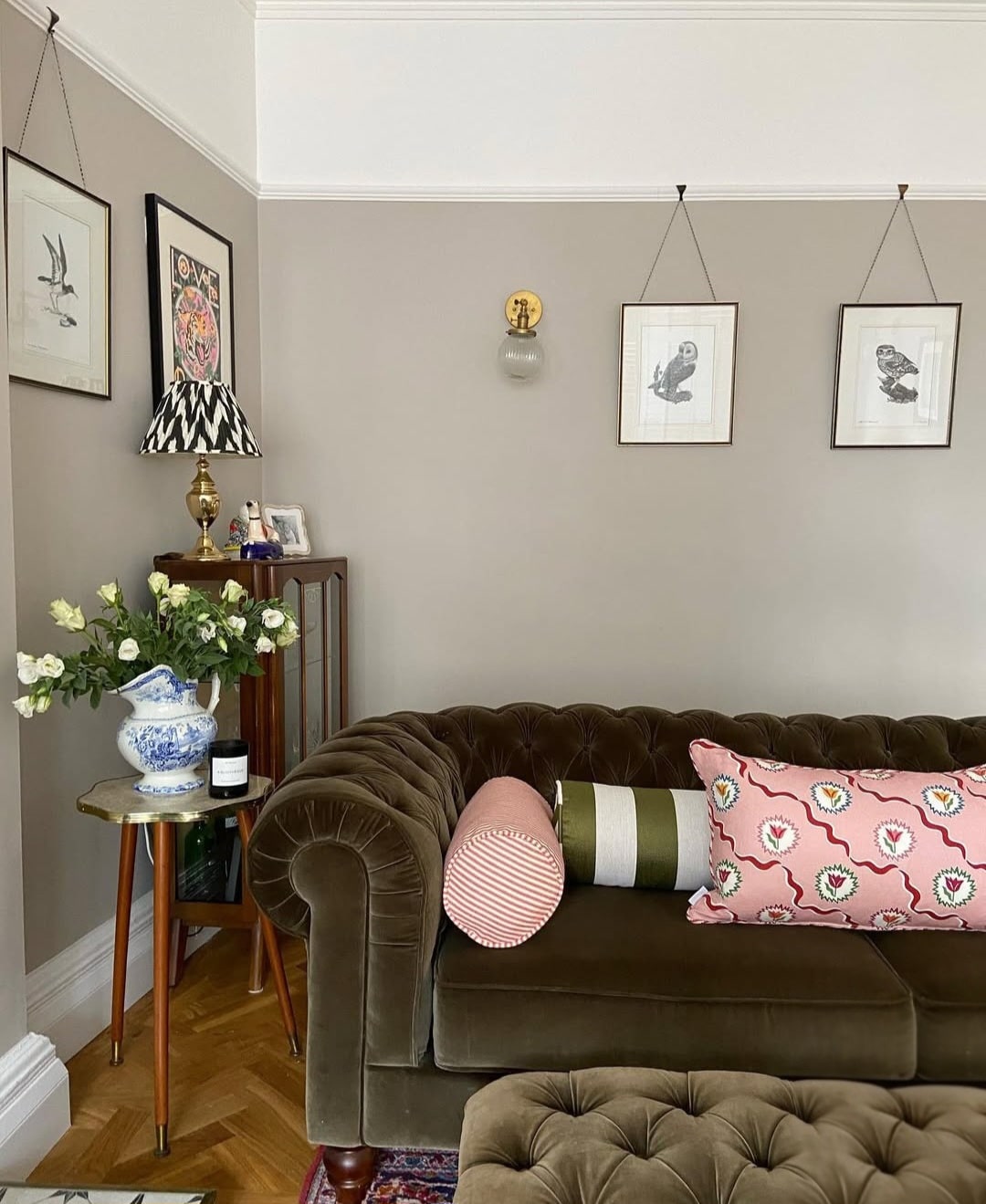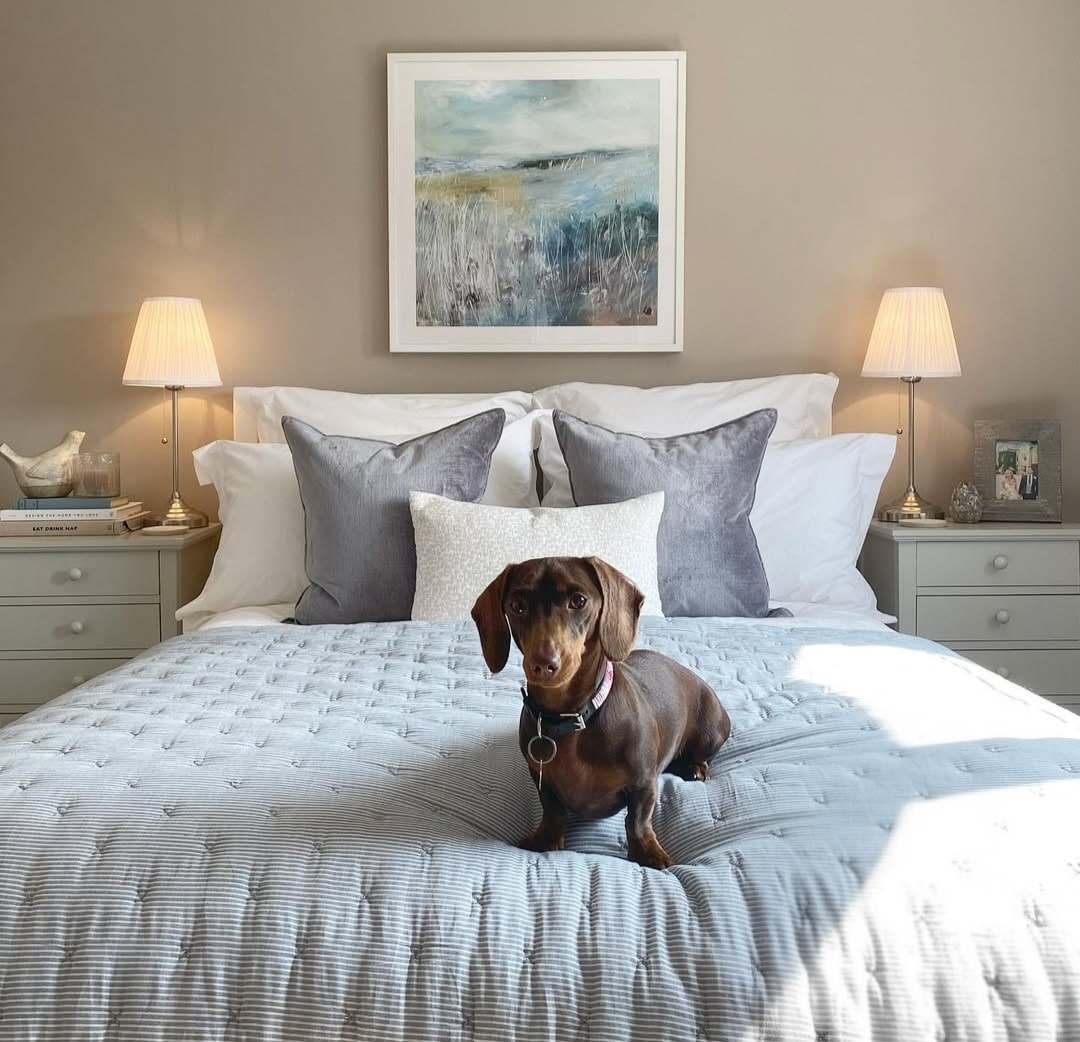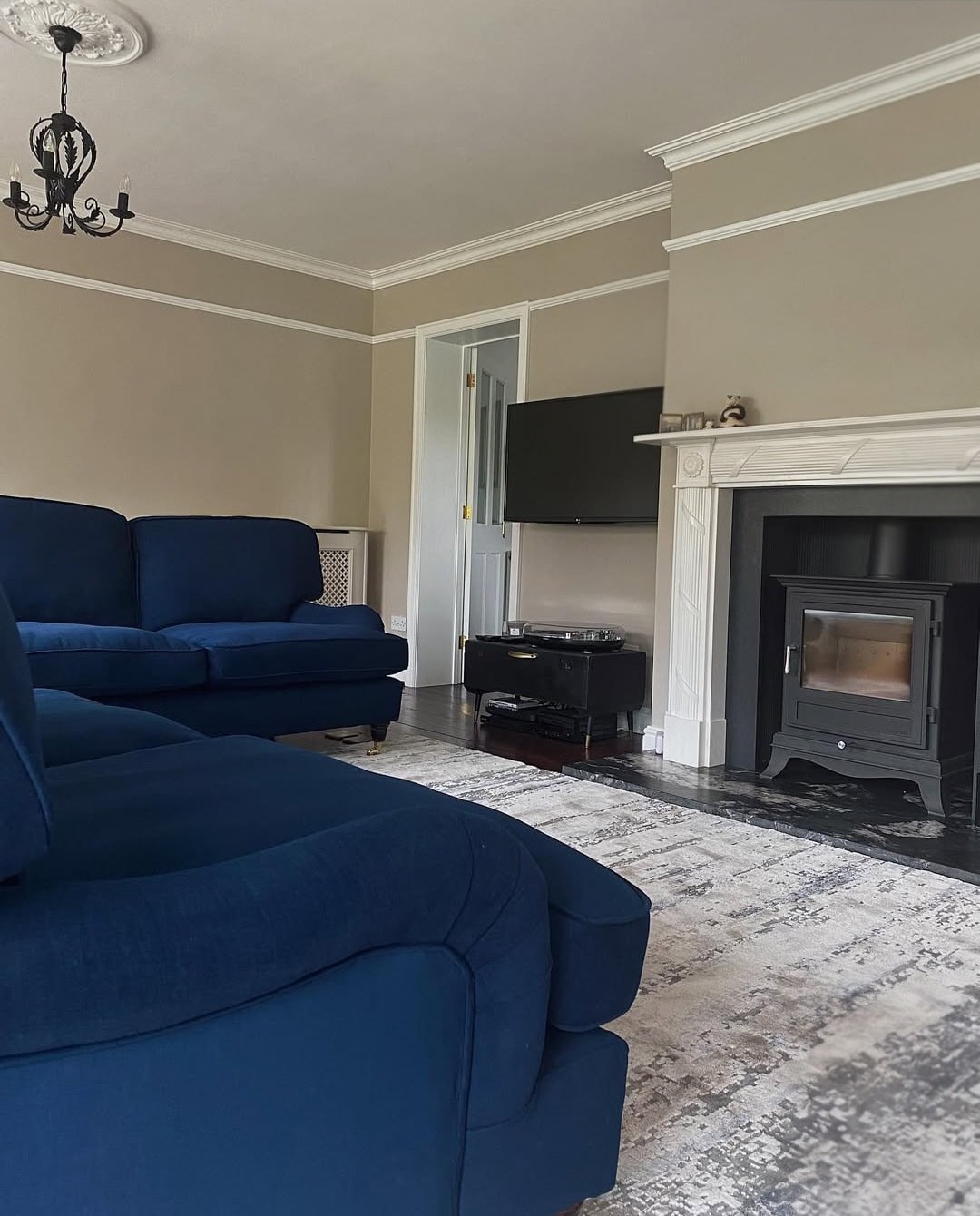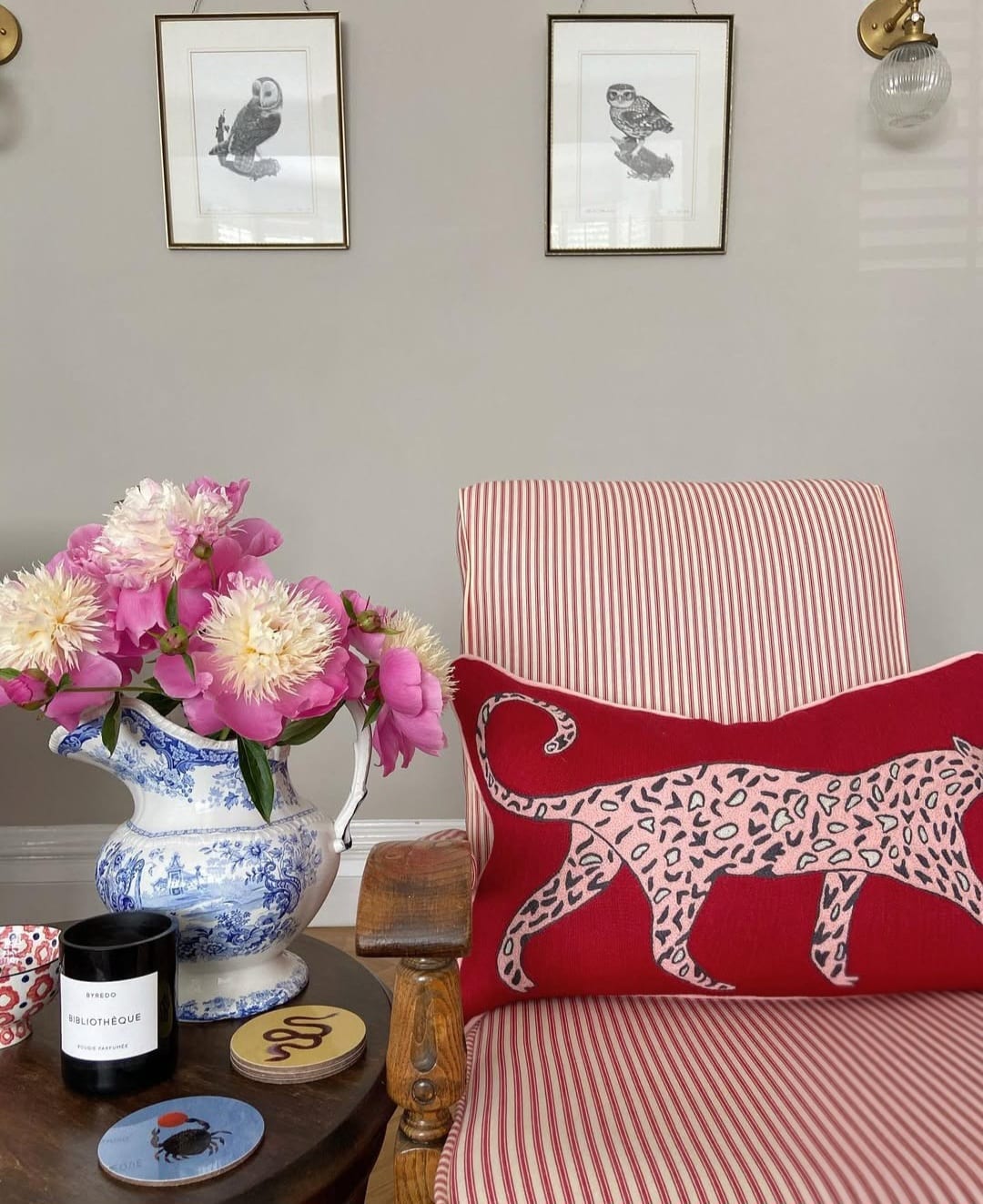
Elephant’s Breath is one of the most popular contemporary grey’s in the Farrow & Ball paint collection. This warm mid grey is an inviting alternative to a bright white or magnolia shade in an interior.
If you’re looking for the perfect pairings in your interior, this Farrow & Ball Elephant’s Breath Colour Scheme explores all of the best combinations and what colours go well with Elephant’s Breath for a cohesive, and well styled interior.
Elephant’s Breath Colour Scheme – What Colours Go With Elephant’s Breath?
Neutral Combinations
Elephant’s Breath has beige and grey undertones, and pairing with similar tonal and neutral combinations creates a beautiful and soft colour scheme.
If you’re looking to use Elephant’s Breath on the walls, F&B suggest using All White on areas such as skirting boards and architraves, and Strong White as an accent colour.
Through my design experience, I personally prefer to carry through the wall colour you use on the skirtings too, especially in small spaces as it instantly draws the eye up. If you start using different colours on the skirtings to what you do on the walls it can cause instant chaos as you’re trying to take in the different colours as you enter a room.
I think choosing one colour also helps with cohesion and flow in the room, so if you’re using Elephant’s Breath on the walls, I’d use it on the skirtings and architraves too.

Defining Accent Combination
When you’re using a neutral in an interior like Elephant’s Breath you should always work to introduce a darker shade into your colour scheme.
Using a darker accent colour like F&B London Clay or Charleston Gray will add a defining colour to the room which will help to frame and ground the space.
If you’re looking to achieve this with paint, there’s plenty of other ways this can be achieved with different paint colours, Railings is a popular choice or you could opt for a standard matte black paint.

Warm, Colourful Combinations
Neutral combinations are one of the most popular Elephant’s Breath Colour Schemes, but incorporating some warmer shades into the mix can create an inviting and welcoming space.
Introduce a daring, wild card shade such as Bamboozle for a touch of rouge. Then ground the room with Wine Dark, a beautiful inky blue that will add definition to a room.
I’m really enjoying these punchy reds in an earthy scheme right now, and it perfectly taps into the ‘unexpected red theory’, the theory that using a singular pop of red in a room is the secret ingredient to pulling a scheme together.

Elephant’s Breath & Cream
Warm greys like Elephant’s Breath tend to pair well with warm, creamy whites that have a similar undertone. For example, a cream with a yellow or beige undertone could complement Elephant’s Breath nicely.
If you’re adding half wall paneling to a bedroom or living room, use Elephant’s Breath on the bottom half to ground the space, lightening and elevating the room with cream on the upper half.

Elephant’s Breath & Black
If you want to create a transitional interior, a black accent will go a long way in pulling an interior together and bringing that all important defining detail to a room.
It contrasts beautifully with Elephant’s Breath for a touch of modernity. A few simple details like a cabinet, light fitting or door hardware is all you need. You’ll then want to incorporate another colour into the equation for some depth and colour in the space – green, brown and brass details are great choices.

Elephant’s Breath & Wooden Tones
Wooden tones continue to grow in popularity through interiors, they give a nod to the natural world outside and an earthy, rustic feel that pairs beautifully with a shade like Elephant’s Breath.
Use one key wooden piece of furniture to work out from, and don’t forget some well placed black accents to pull the room together.

Elephant’s Breath & Grey
Elephant’s Breath is naturally a warm grey/beige with grey undertones so layering with other shades of grey within an interior will build depth and texture.
Opt for a darker grey for a defining edge such as on a bed frame, and do layer with differing shades of grey for further visual interest. This creates a really neutral, yet warm and exciting interior. Think about texture too, differing materials in grey will create that warm, cosy and interesting feel.

Elephant’s Breath & Green
Be it forest green for some added definition or a soft touch of sage green, green makes for a perfect pairing with this warm grey, creating a really earthy, neutral interior.
Use green as an accent colour within the space with furnishings, textiles such as cushions and throws or decorative accessories. If you don’t want to go all in, a really simple way to introduce green is with fake or real plants.

Elephant’s Breath & Bright White
Crisp white half wall panelling like this creates a fresh, modern look when paired with Elephant’s Breath on the upper half. This creates a timeless look that works well in any room.
With this warm grey a continuation after the panelling, it helps to draw the eye up as you enter the room too. Add some touches of green or black for a subtle defining accent in the room. I just love this laid back yet ultra stylish use of colours in this bedroom.

Elephant’s Breath & Brown
You can get away with leaning into darker colours with this F&B shade for added definition, and a deep brown is a lovely way to do this.
How gorgeous does that sofa look in the scheme below? An ideal colour palette if you want to create an elevated or earthy interior scheme.

Elephant’s Breath & Blue
Blue is a gorgeous accent colour to pair with this sophisticated grey. For a coastal inspired design, this really is a perfect colour scheme. May this be your main accent colour and in a bedroom use across your textiles such as cushions and throws.
You can then introduce a third colour such as a lighter neutral to Elephant’s Breath which has been executed beautifully below.

Elephant’s Breath & Navy
Instead of cooler tones of blue, create a high impact look by pairing with a navy or cobalt blue.
Virtually any colour does work with Elephant’s Breath, but if you go down the below route, you won’t want to feature this shade of blue anywhere else in the space to avoid it overpowering the room.

Elephant’s Breath & Stripes
Or why not lean into some red stripes to play on that ‘unexpected red theory’?
It’s bold, it’s high impact and just a small dose is needed to make the most out of this beautiful colour combination.

Elephant’s Breath is one of the most flawless base colours to work with in an interior, it gives a beautiful soft and creamy finish and can be paired with both neutral and bold, statement making shades with ease.
Be it a traditional or modern interior, this mid grey paint colour is a firm favourite!

Thank you for your information.
Could you help me please.
My sitting room is Elephant’s breath.
I have a very old cottage full of old junk but it all seems to look right.
My kitchen is immediately next to the sitting room. It is painted Skimming stone.
What do you think if I repaint the walls here in Elephant’s breath too?
I have lovely old beams holding up my home.
What would you paint the floor in the kitchen?
Again.
Thank you.
Elizabeth
Hi Elizabeth, glad you found it useful. Unless your two rooms flow straight through without an architrave or door I would be inclined to keep the two rooms a separate colour for visual interest. However, if the rooms really flow straight into one another, painting in the same colour can help with creating a cohesive flow through the interior. The beams sound gorgeous! If you’re painting the floorboards, I would opt for something that is going to ground and deliver definition in the space, either a black, dark grey or charcoal shade. White is a popular choice but I find it requires a lot of maintenance and up-keep, hope that helps! Nicole x
HI, thank you for the excellent information on Elephants Breath, can I ask you do you think Elephants Breath would go with Cashmere . Just replaced kitchen units , the colour is Cashmere and its open plan dinning , I was looking at painting walls with Elephants Breath .Thank you ,
Gillian
Hi Gillian, thanks for your comment! Depending on the shade of the cashmere, Elephant’s Breath is slightly darker in tone so it should offset it and complement the kitchen units, I would just recommend a tester pot first to ensure this is the case. If the shades are too similar it will make the space feel flat, as long as it’s slightly more darker and defined against it, it will work well. Hope that helps! Nicole x
Hi,
my bedroom furniture is described as being the same shade as elephants breath. I am trying to pick a neutral shade for the walls to go with this and am torn between dimity and possibly tailor tack. Do you have any advice or recommendations?
Hi Nicola, thanks for your comment. Tailor Tack has a slightly pinker tone than Dimity, it also depends the orientation of your room, if it’s North, East or West facing it can be a great choice for bringing in some warmth against Elephant’s Breath which is typically grey toned. Grab a tester pot of each and paint onto a sheet of A4 white paper so you can move around the room and see how they look in different lights. Nicole x
Hi Nicole
Is Elephants Breath a good colour for a small hallway
Thanks Sharon
Good morning Sharon, it is a contemporary grey so it has cooler undertones which can make a small hallway feel darker. Skimming Stone is a similar neutral but warmer undertones, I’d get a tester pot of each and see how they sit in your space, if you have light that comes in from other rooms though Elephant’s Breath will be workable, Nicole x
I am thinking of painting my kitchen cabinets in Elephants Breath or Shaded White.
Grey metal knobs to be added to the units
Walls are terracotta, tiles are white and surfaces are mid grey stone with blue/orange and mauve undertones.
Kitchen is North/East facing but does have a window on each aspect.
I like Elephants Breath but don’t want to create too dark a feel.
Thanks for your comment, I love both the colours. Based on what you have said without seeing it visually, I would stick with Shaded White. Elephant’s Breath is a gorgeous colour and it would add definition but it veers on the cold grey side which can be in an issue in North/East facing spaces. Shaded White is a great complement to terracotta. What I would say is if you are still unsure, get a tester of each and paint an entire A4 sheet of paper and sit with them in the space, moving the paper around to all aspects of where the cabinets are so you can see how the light affects it. Nicole x
Hi I’m painting one wall in my living room in elephants breath. Will the rest of the walls painted in off white colour work
Thankyou
Amanda
Hi Amanda, thanks for your comment! Yes, absolutely – depending on the undertone of the off-white I would just check with a tester that they both suit in the same space, but generally speaking elephant’s breath does work with most off-whites because of its darker pigment so it contrasts well. Hope that helps, Nicole x
Hi Nicole
Loving your material, I have got Egpytian cotton on my walls in my living room. I just got panel boxes on one whole wall. Do you think Elephants breath will go with egyption cotton ?
Thanks
Hi Tauqeer, thanks! Elephants Breath is only a touch darker than Egyptian Cotton, but in practice it should work as it’s a slightly darker shade, so if you want a neutral feel throughout, go for it! Definitely still worth grabbing a tester first to see how it feels sitting next to the Egyptian Cotton. Thanks, Nicole
Hi
I’ve painted a large sitting room with elephants breath , north facing .
Looks lovely.
I’ve always had a cream sofa , but I replaced it with dark grey covers . I’ve dark wood floor .
I’m not sure what colour curtains to go for and what colour rug ..
thank you
Hi Lynn, thanks for your comment and apologies for the delayed response as I have been travelling! Love elephant’s breath, gorgeous colour. I would lean towards lighter colours on the curtains and rug to contrast and lighten the space. Rug – look at cream looped wool like this style (https://www.benuta.co.uk/wool-rug-hector-beige-60006860-21101.html#MzQwODUz) OR oriental style rug like this (https://www.kukoonrugs.com/products/washable-light-green-bordered-area-rug) – curtains, look at oatmeal coloured curtains, floor length. Hope that helps! x